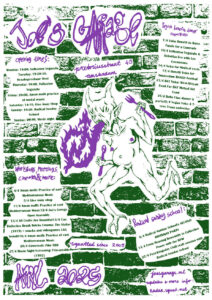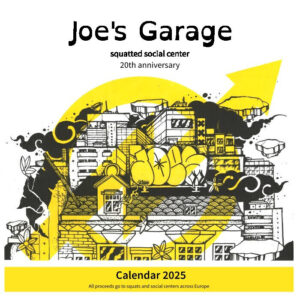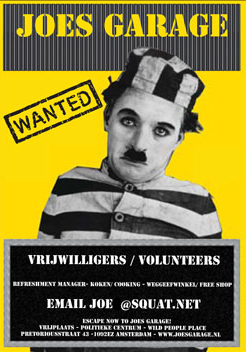 Sunday January 21st 2018. From 18:00, Vegan Pinxto, yes vegan hapjes. From 20:00, documentary screening: Dead City (Ciutat Morte) by Xavier Artigas and Xapo Ortega (2013). 120 min. In Catalan and Spanish. with English subtitles.
Sunday January 21st 2018. From 18:00, Vegan Pinxto, yes vegan hapjes. From 20:00, documentary screening: Dead City (Ciutat Morte) by Xavier Artigas and Xapo Ortega (2013). 120 min. In Catalan and Spanish. with English subtitles.
We’re screening this film after the recent events on 7 December 2017 in Zaragoza. A fascist dies. Within less than a week, Rodrigo Lanza is all over the news, accused of the murder. The social center Kike Mur is under siege. Rodrigo Lanza again? Isn’t strange considering what is happening in the Spanish State? Rodrigo was sentenced to four and a half years in January 2008 in the 4F case.
Free Rodrigo Lanza! La lucha continúa, y contra el fascismo ni un paso atrás.
Synopsis: 800 people illegally occupy an old movie theater in Barcelona in order to screen a documentary. They rename the old building after a girl who committed suicide in 2011: Cinema Patricia Heras. Who was that girl? Why did she kill herself and what does the city have to do with it? That’s exactly what the squatting action is about: letting everyone know the truth about one of the worse corruption cases in Barcelona, the dead city.

Ciutat Morta (Dead City) is a documentary about the case known as 4F, one of the most controversial cases of police, judicial and governmental corruption experienced in Barcelona in the last years. The case perfectly illustrates the common practices of scapegoating and torturing and the widespread racism within the law enforcement institutions in the Spanish State.
On February 4th, 2006, a flowerpot was thrown from a squat (owned by the City Council) in which a party was taking place, seriously wounding a police agent. There were nine arrests that night. The City Council and the police, in view of the impossibility of finding out who had thrown the flowerpot, decided to mount a case blaming innocent people who were not in the house and some not even in the vicinity.
Patricia Heras was cycling that night and had an accident in a different area. She was taken by ambulance to the same hospital as the police officer. Due to her appearance – punk/squatter – she was also charged with assaulting a police officer and throwing a fence at him. Patricia received three years and the other arrestees were given minor convictions. Patricia committed suicide in April 2011, when she had a prison permit to visit her home.
Rodrigo and his mother Maria have leaded the campaign for justice for the 4-F defendants and promise they will go to the European Court of Human Rights if necessary. Rodrigo was released in December 2012. He’d spent two years on remand, one year on bail and three more years in prison. He received sympathies from the other prisoners and was hated by the screws, however he always declined the favours offered if he pleaded guilty. When he appealed in June 2009, his sentence was incremented from four and a half to five years. Rodrigo will always remember the first words he heard when he encountered the police that unfortunate 4th of February: “los sudacas de mierda por aquí” (those fucking sudacas round here – sudacas is a racist slur against South Americans); Rodrigo immediately knew he wasn’t going to be treated lightly.
Comunicado de Juan Pintos, detenido/encarcelado/condenado por el montaje del 4F – 26 january 2015 http://barcelona.indymedia.org/newswire/display/493810/index.php
Comunicado por la libertad de Rodrigo Lanza – 15 december 2017 http://barcelona.indymedia.org/newswire/display/517093
Comunicado de la madre de Rodrigo Lanza – 17 december 2017 http://www.alasbarricadas.org/noticias/node/39382
Comunicados de CSO Kike Mur, Metromuster y CGT en apoyo a Rodrigo Lanza y contra la criminalización del antifascismo – 23 december 2017 http://barcelona.indymedia.org/newswire/display/493810/index.php
A letter from prison, by Rodrigo Lanza – 2 january 2018 https://www.indymedia.nl/node/42613
Desde las mazmorras, aislado, pero no solo. Rodrigo Lanza 2 january 2018 http://barcelona.indymedia.org/newswire/display/517528
Film night at Joe’s Garage, cozy cinema! Free entrance. You want to play a movie, let us know.
 Sunday February 11th 2018: Movie night: Strike (Eisenstein, 1925). Doors open at 8pm, film starts at 8:30pm.
Sunday February 11th 2018: Movie night: Strike (Eisenstein, 1925). Doors open at 8pm, film starts at 8:30pm.










